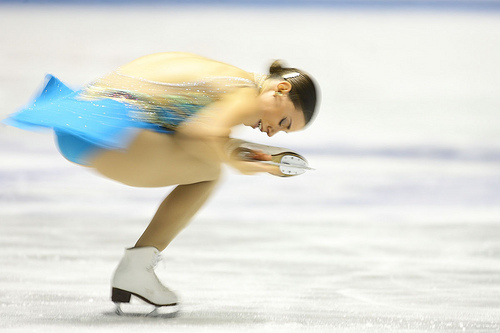
The friction coefficient of cartilage is very similar to ice skating. The picture (cc) is by Tsutomu Takasu
A systematic review by Jakobsen et al (2005) found that the average study quality on treating cartilage defects (= chondral injuries, traumatic, not osteoarthritis) was just 43 out of 100. They found only 260 randomized patients! We are therefore craving for new, good research.
In the June 2012 JBJS Am issue there were two nice articles on treatment of cartilage defects and together with Bentley et al’s awesome article in JBJS Br April issue there is now some new evidence, craving comments
I’m splitting this post into several:
- Basics about cartilage & microfracturing
- Krych retrospective study (JBJS Am)
- Crawford’s RCT (JBJS Am)
- Bentley’s 10 year follow-up RCT (JBJS Br)
What is joint cartilage?
The articular (joint) cartilage is a fascinating structure. When you look at it in a healthy joint it’s like watching a perfectly prepared white ski slope. It protects our joints by deforming when we put load on it and thereby redistributing the load over a larger surface. It also has an impressive friction coefficient similar to ice skating (0.04-0.002, type of lubrication: elastohydrodynamic)!
The white stuff is mostly water (75 %), collagen (type II, not type I like in bone) and sugar coated proteins (proteoglycans). A few brave cells, the chondrocyte resupply with new material. Chondrocytes are basically the lone rangers of the body since the joint is cut-off from the blood supply (avascular). They eat whatever the joint fluid can provide them with.
Some trauma, usually rotational forces, can cause large chunks of cartilage to be stripped off. When you look into such a knee you’ll find a big gaping hole in the ski slope, often with bone at the bottom. The chondrocytes do unfortunately a very poor job in healing the injury. It can only heal when the injury goes into the bone (past the tidemark layer). This since the bone marrow then releases stem cells into the joint that cover the surface with scar tissue similar to cartilage.
Microfracturing
The most commonly method for fixing the cartilage is microfracturing (popularized by Steadman et al). By making small holes into the bone you get an injury that is artificially deep injuries (see above). Unfortunately you don’t get the same beautiful ski-slope back, the scar tissue is white but it’s usually not as smooth and when you look at its composition you find a lot of type I collagen instead of the usual type II.
The problem is that studies may show promising short term but then deteriorate. Harris et al noted in their review 2010 that microfracturing fare worse after a few years than more advanced techniques (chondrocyte implantation and osteochondral transplantation = mosaicplasty). The return to preinjury sporting activity is a disappointing 60-70 % after 1 year. In one study they looked at 1/3 had stopped the sporting activity after another 2 years.
I think most agree that microfracturing is a simple technique, good for small injuries but should be followed-up. What to do at the follow-up? Well… that’s what I’m going to look into in the coming posts.

